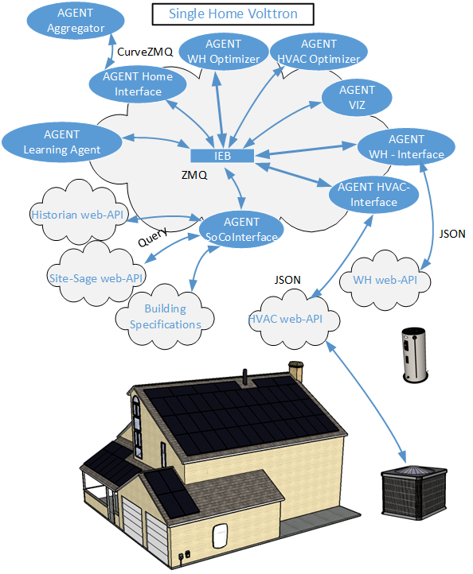In 62 new homes in suburban Birmingham, Alabama and 46 townhomes under construction in the Upper West Side of Atlanta, Georgia, Eclipse VOLTTRON is helping enable futuristic approaches to optimize residential energy usage and delivery. Both residential developments are part of the Smart NeighborhoodTM initiative, where the US Department of Energy’s Building Technologies Office (BTO), Southern Company, Alabama Power and Georgia Power will research how neighborhoods of the future could function to better serve customers. Both projects include grid-interactive efficient buildings (GEB) - smart home technologies in highly energy efficient homes.
More information about the Smart Neighborhood initiative is available here.
“Eclipse VOLTTRON Inside”
Each Smart Neighborhood home in Birmingham and Atlanta has a dedicated Eclipse VOLTTRON instance. VOLTTRON was developed by Pacific Northwest National Laboratory under funding provided by the U.S. Department of Energy (DOE) Building Technologies Office (BTO). In 2018 VOLTTRON was transitioned to the Eclipse Foundation for management as open source software. VOLTTRON supports numerous applications for managing energy loads, increasing building efficiency, integrating distributed renewable energy, and accessing storage.
In the Smart Neighborhood homes, VOLTTRON interacts with the home’s heating, ventilation and air-conditioning and water heating systems. The deployment of VOLTTRON creates a connected system that can facilitate decisions about available power sources and energy usage optimizing for both price and reliability. Based on data inputs including weather, solar irradiance, load forecasts and time of use pricing, the Smart Neighborhoods’ neighborhood master controller optimizes battery storage and power generation to minimize overall system cost. According to an Oak Ridge National Laboratory presentation, here is an illustration of the Smart Neighborhood’s home VOLTTRON architecture:

In Birmingham, a community-scale microgrid, made up of solar, battery storage and natural gas generator, has been deployed just down the street from the neighborhood. VOLTTRON instances, operating in a cloud computing environment, optimize each home’s devices. A VOLTTRON aggregator, also operating in the cloud, interacts with an ORNL-developed microgrid controller (CSEISMIC) that optimizes the community microgrid resources. The ORNL home optimization includes algorithms to forecast and optimize home energy use in response to signals from the microgrid controller. In the Atlanta neighborhood, VOLTTRON instances will interact with rooftop PV and in-home battery energy storage and with a CSEISMIC instance for the neighborhood.
Each home’s VOLTTRON instance interacts with several different devices, controllers and data sources, including:
Optimizer Agent
HVAC Interface
Water Heater Interface
Learning Algorithms
Historians
Energy and Weather Forecasting Algorithms
CSEISMIC Microgrid Controller (Birmingham)
A Living Laboratory
The Eclipse VOLTTRON instances also enable the Smart Neighborhood to serve as a testbed for transactive controls and market experiments.
According to ORNL lead scientist Teja Kuruganti,
Leveraging the Eclipse VOLTTRON platform, we can develop transactive controls to utilize a virtual storage environment, provide cost optimization of energy consumed by the homeowner, maximize the use of local generation and storage, and maximize the neighborhood’s flexibility to assist in utility-level operations.
For those who appreciate both the promise and the technical challenge associated with buildings-to-grid research and development, Southern Company’s Smart Neighborhoods in Birmingham and Atlanta are extremely exciting.
A recent ORNL blog post declares that success in Birmingham and Atlanta will help establish the technical feasibility of a neighborhood-level, buildings-to-grid integration strategy and residential transactive controls for end-use energy management. It will also provide an in-situ demonstration of the tangible and quantifiable benefits of a transactive energy ecosystem to both homeowners and utilities.
Conclusion
To Ace IoT Solutions, the Southern Company’s use of the VOLTTRON platform helps further validate our belief that the open source platform has the capability to transform the way property owners manage energy consumption and utilities handle power generation.
For more information about ACE IoT Solutions, please visit our website. To download (at no cost!) the Eclipse VOLTTRON platform, please visit
https://projects.eclipse.org/projects/iot.volttron/downloads


